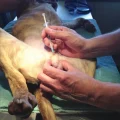Dogs are known for their curious nature and their tendency to explore their surroundings with their mouths. However, this can sometimes lead to them swallowing foreign objects, such as push pins. While it is a concerning situation, there are steps you can take to help your dog and ensure their safety.
The first thing you should do if your dog swallows a push pin is to stay calm. Panicking will not help the situation, and it is important to approach the situation with a clear mind. It is also crucial to never try to induce vomiting in your dog without consulting a veterinarian first, as some objects can cause more harm if brought back up.
One of the most important steps to take is to contact your veterinarian immediately. They will be able to provide you with guidance on what to do next. In some cases, they may advise you to monitor your dog closely for any signs of distress or discomfort. However, depending on the size and shape of the push pin, they may recommend bringing your dog in for an examination.
Some signs that your dog may have swallowed a push pin or another foreign object include pawing at the mouth, drooling, vomiting, gagging, or choking. If you notice any of these symptoms, it is essential to seek veterinary attention right away.
In some cases, your veterinarian may recommend a wait-and-see approach. They may advise you to feed your dog a bulky meal of dry food or a slice of plain bread. This can help cushion the object and promote its movement through the digestive tract. Additionally, the activation of digestive juices through food consumption can help soften any wads of rawhide or other materials, making them easier to pass.
However, it is important to note that the time it takes for an object to pass through a dog’s digestive system can vary. Generally, it can take anywhere from 10 to 24 hours for ingested items to move through the entire digestive tract. Some objects, though, can remain in the stomach for extended periods, even up to several months.
If the push pin or foreign object is larger than 1.5 inches in diameter, it is unlikely to pass further into the small intestine. In such cases, your veterinarian may recommend an X-ray or other imaging techniques to assess the position and potential risks associated with the object.
Ultimately, the best course of action when your dog swallows a push pin or any other foreign object is to consult your veterinarian. They will provide you with the most appropriate advice and treatment options based on your dog’s individual situation. Remember, it is always better to be safe than sorry when it comes to your furry friend’s health and well-being.

What Can I Give My Dog To Help Them Pass An Object?
It is important to consult with your veterinarian before attempting to treat your dog at home. However, if your dog has swallowed an object and you are waiting for veterinary advice, there are a few things you can try to help them pass the object more easily.
1. Bulky meal of dry food: Feeding your dog a bulky meal of dry food can help cushion the object and potentially aid in its passage. The bulkiness of the meal may help push the object along the digestive tract.
2. Slice of plain bread: Giving your dog a small slice of plain bread can also help cushion the object and potentially aid in its passage. The bread may provide a protective barrier around the object, making it easier to move through the digestive system.
3. Activating digestive juices: Food can stimulate the production of digestive juices, which may help soften and break down objects, such as wads of rawhide. This can make it easier for the object to pass through the digestive tract.
Remember, these suggestions should only be considered as temporary measures while you wait for veterinary advice. It is crucial to seek professional guidance to ensure the safety and well-being of your dog.
How Do I Know If My Dog Swallowed Something Sharp?
To determine if your dog has swallowed something sharp, there are several signs you can look out for:
1. Changes in behavior: If your dog suddenly becomes restless, agitated, or appears to be in discomfort, it could be a sign that something sharp is causing internal pain.
2. Loss of appetite: If your dog refuses to eat or shows a decreased interest in food, it could be an indication that something is causing discomfort in their digestive system.
3. Difficulty swallowing: If your dog is having trouble swallowing or is repeatedly attempting to swallow without success, it could suggest that a sharp object is lodged in their throat.
4. Excessive drooling: Excessive drooling can occur when a foreign object irritates the mouth or throat, causing your dog to produce more saliva than usual.
5. Vomiting: If your dog vomits and you notice blood or a foul odor in the vomit, it could indicate that a sharp object has caused damage to their digestive tract.
6. Lethargy or weakness: If your dog appears to be unusually tired, weak, or lacks energy, it may be a result of internal injuries from swallowing a sharp object.
7. Abdominal pain: If you notice your dog repeatedly stretching out, arching their back, or showing signs of discomfort when their abdomen is touched, it could be an indication that something sharp is causing internal pain.
If you suspect that your dog has swallowed something sharp, it is crucial to seek immediate veterinary attention. A veterinarian will be able to perform a thorough examination, possibly including X-rays, to determine the location and potential damage caused by the foreign object. Prompt medical intervention is essential to prevent further complications and ensure the well-being of your furry friend.
How Big Of An Object Can A Dog Pass?
When it comes to the size of objects that a dog can pass, it depends on several factors such as the size and breed of the dog, as well as the specific object in question. Generally, dogs are capable of passing objects that are smaller in size, typically around 1.5 inches in diameter or smaller.
However, it is important to note that this is a general guideline and not an absolute rule. Dogs have different anatomical structures and digestive systems, so what one dog may be able to pass, another dog may not. Additionally, the shape and texture of the object can also impact whether a dog can pass it or not.
To provide a more comprehensive answer, here are some examples of objects and their approximate sizes that a dog may be able to pass:
1. Small toys or objects: Objects such as small rubber balls, small plastic toys, or small pieces of fabric, which are less than 1.5 inches in diameter, may be able to pass through a dog’s digestive system.
2. Bones: Dogs are known for chewing on bones, but it is important to note that cooked bones can splinter and cause harm to a dog’s digestive tract. If a dog ingests a bone, it is recommended to consult a veterinarian, regardless of the size.
3. Small rocks or pebbles: Dogs may accidentally ingest small rocks or pebbles while playing or exploring. If the rocks or pebbles are smaller than 1.5 inches in diameter, they may pass through the digestive system. However, if they are larger or if the dog shows any signs of discomfort, it is important to seek veterinary attention.
4. Foreign objects: Ingesting foreign objects such as coins, jewelry, or small household items can be dangerous for dogs. While smaller objects may pass through the digestive system, it is crucial to consult a veterinarian as soon as possible to ensure the dog’s safety.
It is important to monitor your dog closely and take precautions to prevent them from ingesting objects that could be harmful. If you suspect that your dog has ingested an object or is experiencing any discomfort, it is always best to consult a veterinarian for proper evaluation and guidance.
How Long Does It Take A Dog To Pass A Foreign Object?
The time it takes for a dog to pass a foreign object can vary depending on several factors. Ingested objects typically take anywhere from 10-24 hours to move through the entire digestive tract. However, it’s important to note that certain objects can remain in the stomach for longer periods of time, sometimes even months.
Factors that can affect the passage time include the size and shape of the object, the dog’s size and breed, and the overall health of the digestive system. Larger objects may take longer to pass through the intestines, while smaller objects may be eliminated more quickly.
If a foreign object becomes lodged in the digestive tract, it can cause a blockage or obstruction. In such cases, the object may not pass naturally and veterinary intervention may be required. Signs of a blockage can include vomiting, diarrhea, abdominal pain, lack of appetite, and lethargy.
If you suspect that your dog has ingested a foreign object or is experiencing any symptoms of a blockage, it is important to consult a veterinarian as soon as possible. They will be able to evaluate the situation and determine the best course of action, which may include diagnostic tests, medication, or surgery.
To summarize, the time it takes for a dog to pass a foreign object can vary, but typically ranges from 10-24 hours. However, if a blockage occurs, veterinary intervention may be necessary to ensure the dog’s health and well-being.
Conclusion
Dogs are curious creatures that sometimes find themselves in situations where they accidentally swallow foreign objects. This can be a cause for concern as these objects can cause blockages or other complications in their digestive system. It is important for dog owners to be aware of the signs that their dog may have swallowed something and to seek veterinary attention immediately.
If you suspect that your dog has swallowed a foreign object, look out for symptoms such as pawing at the mouth, drooling, vomiting, gagging, or choking. These signs indicate that the object may be causing discomfort or obstruction in their digestive tract. Ignoring these symptoms can lead to serious complications and should be taken seriously.
In some cases, it may be possible to help the object pass through the digestive system by feeding a bulky meal of dry food or a slice of plain bread. This can help cushion the object and aid in its movement through the intestines. However, it is crucial to consult with your vet before attempting this, as they will be able to assess the situation and provide appropriate guidance.
It is also important to note that the time it takes for ingested objects to move through the digestive tract can vary. While most objects pass within 10-24 hours, some can remain in the stomach for longer periods of time. This emphasizes the importance of seeking veterinary attention promptly, as prolonged presence of foreign objects can lead to complications such as blockages or damage to the digestive system.
Being aware of the signs that your dog may have swallowed a foreign object and taking immediate action can help prevent serious complications. Regular monitoring of your dog’s behavior and ensuring their environment is free from potential hazards can also help reduce the risk of accidental ingestion. Remember, your veterinarian is the best resource for guidance and treatment in these situations, so do not hesitate to reach out for their assistance.












